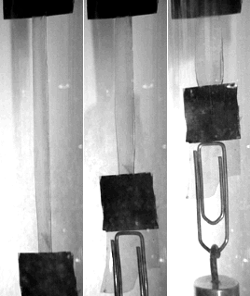Elastomers Make Light Work

Engineering becomes easier when you substitute moving materials for moving parts, especially in small machines. This explains the appeal of piezoelectrics, which change shape in response to voltage. But they stretch by only a few percent, and researchers hanker for more. Many are eyeing nematic elastomers, which can deform 400% in response to heating or cooling.
To synthesize nematic elastomers, chemists start with a gloppy liquid of polymers–chain-like molecules thousands of subunits long–from which long, rigid, “pendant” molecules dangle. The researchers add so-called crosslinker molecules that fasten chains together in an irregular network and convert the liquid to a jelly-like solid. Next, they stretch the material–which aligns the pendants–and add more crosslinkers, to maintain the stretched state after the tension is released. Heat disorders the pendants and causes the material to contract along the original axis of tension. Cooling enables the pendants to re-align and the material to re-expand.
Researchers have added photosensitive molecules to these orientable networks before, but only as switches to control how the materials bend light. Absorbing a photon can force a photosensitive cluster of atoms to reposition a chemical bond and create a kink in a polymer chain. A pair of chemists at the University of Freiburg in Germany was surprised to find that the same kinks can also cause contraction. Their elastomer incorporated the usual photosensitive units, but only in the crosslinkers they attached under tension.
The researchers measured how strips of material shortened and lengthened with changes in temperature and illumination, and they asked Cambridge University physicists to help explain what they saw. The two types of data were consistent, given some assumptions from liquid crystal theory, and the team concluded that both light and heat shortened the strips by reducing the number of aligned pendants.
Tom Lubensky of the University of Pennsylvania in Philadelphia says that the model the Freiburg-Cambridge team used probably wasn’t the only viable choice, but he credits them with “a basic understanding of what’s going on.” Most interesting, he says, is the new material, which he predicts will find uses operating even as slowly as it does. Lubensky expects bigger but not necessarily faster effects with other molecular architectures. “If it has to do with the mechanical properties of an elastomer,” he says, “they don’t have much wiggle room.”
But B.R. Ratna of the Naval Research Laboratory in Washington, DC, says moving the kinking unit from the crosslinker to the pendant will make things a lot faster. “Definitely at least an order or two of magnitude change you can expect,” says Ratna.
–Oliver Baker
Oliver Baker is a freelance science writer based in Davis, CA.


